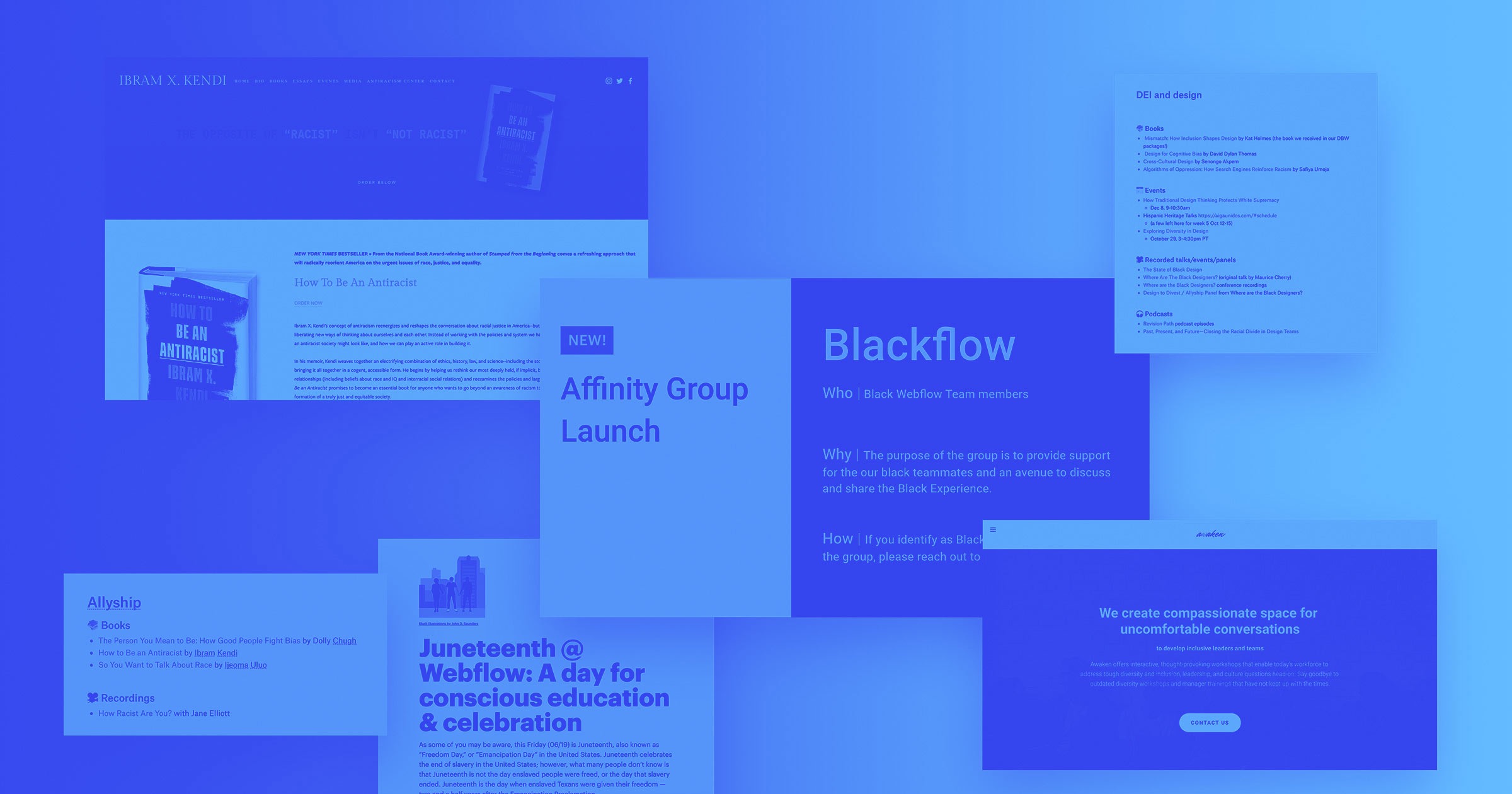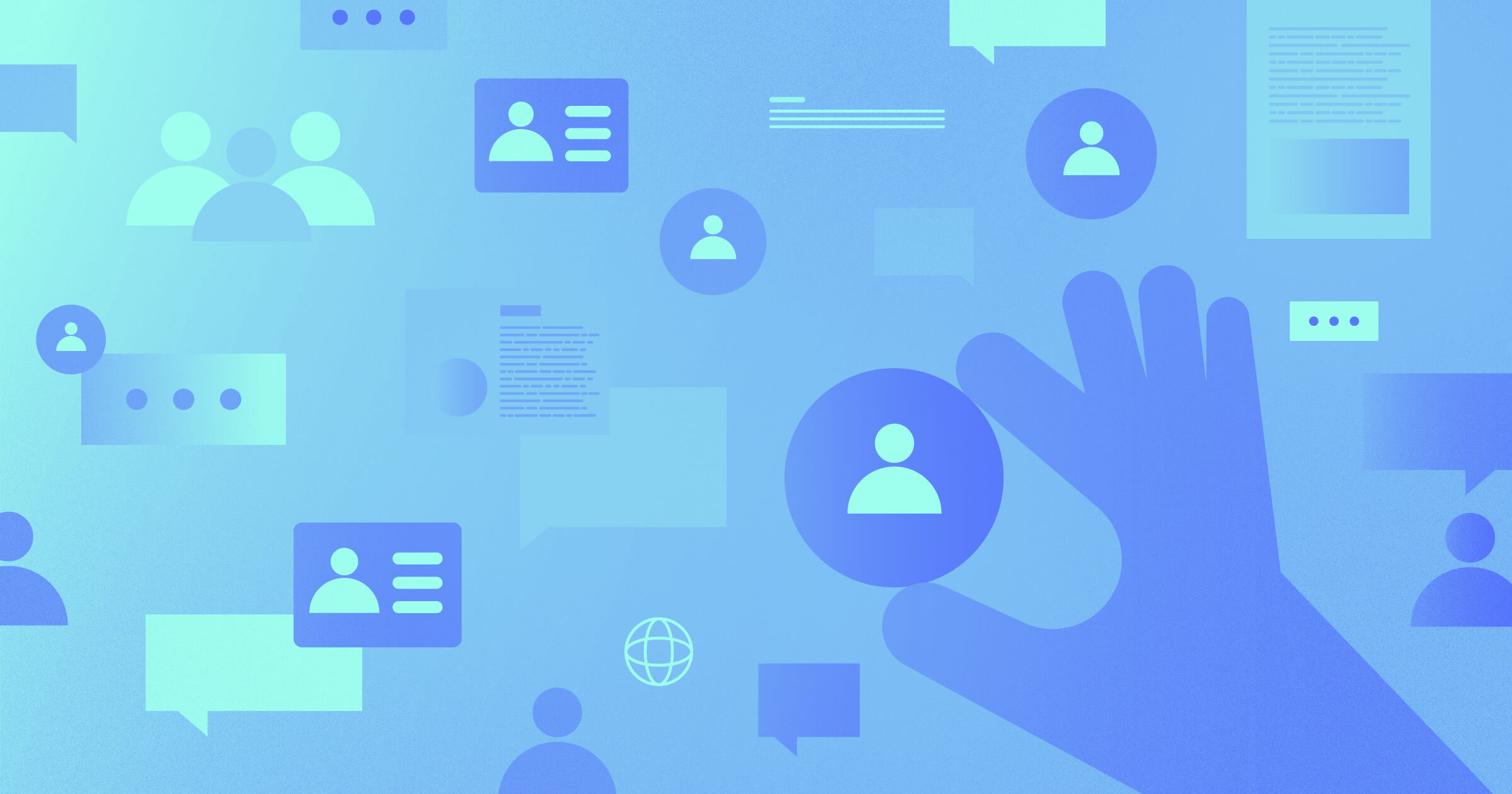At Webflow, we believe that fighting racial inequality isn’t just a moral imperative, it’s core to our ability to succeed and fulfill our dual missions: to democratize access to the web, and lead fulfilling and impactful lives while we do it.
While we’ve long held the belief that combating racial injustice and inequality is important, the past few months have exposed an uncomfortable but urgent reality: even our best beliefs and intentions aren’t enough to protect, support, and save Black lives.
A few months ago, we made a public commitment to moving beyond our intentions and into intentional action against systems of racism and white supremacy. Since we made our public statement, we’ve been engaging in the discussions, reflections, and actions as a team to help accelerate our anti-racism journey — but until now, all of that work has been behind closed doors.
Today, we’re excited to change that, and to share an update on our anti-racism journey — not just what we’ve done, but what we’ve gotten wrong, and what we’ve learned along the way.
What does anti-racism mean at Webflow?
At Webflow, anti racism is defined by our actions, not our beliefs. To be anti-racist, as an organization and individuals, means that we’re actively and consistently working to identify the systems, policies, and practices that promote racial inequality. To be anti-racist means that we’re changing those systems to ensure equitable outcomes for racial groups.
At the heart of our definition is a belief that has been best articulated by Netflix’s VP of Inclusion Strategy, Verna Myers:
“Neutrality at this point is complicity with the status quo, and the status quo is racism. We may not have created it, we don’t believe in its tenets, but at this point, racism doesn’t need our beliefs to survive… So in order for us to get rid of it, we have to be intentional. We have to act. We have to be anti-racist.”
If anti-racism is a journey, where are we starting from?
Before we started developing our anti-racism plan, we wanted to understand where we were starting from — and not just from the standpoint of Black representation. While we believe increasing Black representation is important, we also acknowledge that the focus on hiring and representation can distract us from the more difficult but important work of amplifying and empowering our own Black teammates.
To better understand the experiences of our Black teammates, we turned to our CultureAmp Engagement Survey data (April 2020) , and here’s what it told us:
Black representation: 4% of our workforce identified as Black/African American
Black belonging: 100% of Black employees felt like they belong at Webflow
Black inclusion: 60% of Black employees believed they can be their authentic selves
Black enablement: 40% of Black employees believed people from all backgrounds have equal opportunities to succeed at Webflow
These insights not only gave us an idea of where we started, but they also helped us prioritize and strategize a short- and long-term approach to anti-racism as an organization. Our top priorities in our anti-racism efforts are:
- Empower our Black employees by providing a space for them to be their authentic selves — to be Black. To be angry, afraid, disenchanted, or even disengaged from work.
- Increase Black representation on our team and especially in our leadership.
- Call in our non-Black teammates, especially those in leadership positions, by creating learning and engagement opportunities about anti-Black racism and authentic allyship.
- Engage our executive team and people leaders as active advocates for anti-racism, acknowledging that each individual has a different starting place, and meeting them where they are.
What have we done so far?
We haven't been perfect in our anti-racism journey and still have a lot of work ahead of us. Looking to the future requires acknowledging the progress we've made. Most importantly, to acknowledge and appreciate those who’ve made our progress possible. The actions and efforts we outline below are not a reflection of my work, or the work of any individual at Webflow — they’re a reflection of a collective and awe-inspiring commitment from Webflow teammates, leaders, and external partners.
As a Black woman and DEI practitioner, these past few months have been both incredibly difficult and awe-inspiring. Out of the depths of collective despair, grief, and anger, I was truly inspired by the number of individual teammates and leaders who took thoughtful action, initiative, and accountability for uprooting systems of inequality and injustice at and beyond Webflow. Today, I’m honored to name and express gratitude for those individuals and the work they’ve contributed to our anti-racism journey.
Here’s what we’ve done in the past few months to advance our anti-racism efforts at Webflow:
Actions to empower our Black employees
- In June, we launched Blackflow, our Black affinity group. In addition to funding Affinity Group activities and initiatives, such as trauma and healing sessions, we also compensate our Affinity Group leads (across all groups) for the time and energy they invest in creating these spaces.
- In August, we launched mandatory anti-Black racism and authentic allyship workshops for all people managers at Webflow.
- We give our Black employees explicit and public permission to call in Black. A recent example of this was after it was announced that no one would be criminally charged for the murder of Breonna Taylor. In response, our CEO, Vlad, sent this to the team:
“To our Black teammates, if you need to take any paid time off to cope and heal, you have my direct support to do that. If there is any concern about projects or upcoming deadlines, I will work directly with your manager to make sure that work is distributed or reprioritized. Your health, safety, and well-being come above all else.”
- We’re hosting Black trauma/healing sessions for our Black teammates.
Actions to increase Black representation
- We established a company-wide goal to ensure the representation of BIPOC and other underrepresented groups in our final candidate pools to hold our team accountable for more inclusive and equitable hiring practices, and to help drive us towards more equitable hiring outcomes.
- As a result, we increased our Black/African American representation from 4% (April, 2020) to 6% (November 2020)
- We launched mandatory interview training for hiring managers and interview panelists to ensure a structured and objective interview process.
Actions to call in our non-Black teammates and leaders as allies:
- We launched company-wide anti-racism and inclusion trainings with our partners at Awaken.
- We observed Juneteenth as a company-wide day of reflection and education.
- We started a belonging and anti-racism book club, led and facilitated by Sarah Esterman, our Lifecycle Marketing Manager.
- We hosted a fireside chat with Ibram X Kendi to discuss the principles of anti-racism and help our teammates understand how to create an anti-racist workplace. We also purchased his book, How to be an Anti-Racist for our team.
- We created anti-racism and inclusive writing frameworks for our marketing, product, education, and design teams. Credit: Amrita Saraogi, Sarah Esterman, EJ Mason, Shannon Fisher, and Camille Esposito.
- We launched our first diversity, equity, and inclusion (DEI) council with 5 active executive sponsors and 15 active team members.
- We launched an executive alignment series to engage our executive team in ongoing discussions about DEI and anti-racism at Webflow and hold them accountable for championing these efforts.
- We had several teams dedicate OKRs to DEI work, including our design and marketing teams.
- We’ve matched our team’s donations for social justice and anti-racism organizations, resulting in over $100K.
We’re proud of the work we’ve done so far, but we know a lot of work lies ahead of us. We are humbled and proud to have the commitment and engagement of our entire team in this work, and to partner with internal and external advocates. In the coming weeks and months, our focus will be on ensuring that we continue to fund and focus on our anti-racism efforts, and to create sustainable plans of action to ensure that we can continue on our anti-racism journey well into the future. We look forward to sharing more of this work with you, our Webflow community, and continuing on this journey together.
While our anti-racism efforts explicitly address the barriers to success for Black individuals, those efforts truly impact and empower every one of our employees and customers. Herein lies the power of cultivating an anti-racist company: in our effort to center the experiences of Black employees and remove the barriers to their success, we build an organization that empowers all teammates to succeed. And, when we create an organization that enables everyone to succeed, we will truly realize our first mission to create a product that empowers and unlocks the potential of all of our customers. In pursuit of a more just, kind, and empowering workplace and world, it’s time to continue our work.



















Join the global Webflow Community
Connect and build with 85,000+ community members around the world — whether you're new to Webflow or a seasoned designer, there's a place for you.
































